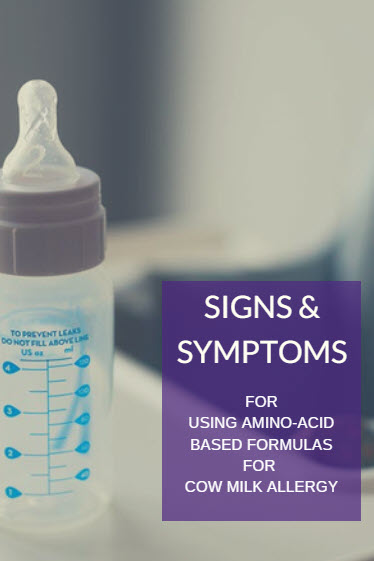When a baby with food allergies needs formula, they need a formula that won’t trigger an allergic response. Hypoallergenic formulas are tailor-made for infants with food allergies. A hypoallergenic formula provides protein from either peptides (extensively hydrolyzed protein, to be exact) or from non-allergenic amino acids. But extensively hydrolyzed formulas (eHF) and amino acid-based formulas (AAF) aren’t the same. An eHF manages symptoms for most infants with CMA (at least 90% of uncomplicated cases, closer to 60% for more severe cases), whereas AAFs are usually used after an eHF “fails” to fully improve symptoms, or for more severe cases. But sometimes the best first choice is an AAF. This leads parents to wonder: how do doctors choose which one to try first for infants with CMA? Will my doctor recommend an eHF or an AAF, like Neocate?
Let’s review potential signs healthcare professionals could look at to determine if a hypoallergenic amino acid-based formula, like Neocate, should be used instead of an eHF to manage cow milk allergy.
Available Types of Baby Formula
First, let’s review available types of baby formulas. The below table provides quick insight into the different types. Understanding formula differences is important in cow milk allergy (CMA). Infant formulas vary by the kind of protein used to make them and the size of the protein. The source and size of protein also determine how allergenic – or likely to trigger an allergic reaction – a formula is.
| Protein Structures in Formulas | Source of Protein | Protein Type / Form | Allergic Reaction Potential |
Whole protein Cow/Soy milk protein |
Cow Milk Goat Milk |
Whole Protein Casein or Whey |
Most Allergenic Least Allergenic |
| Soy Milk | Whole soy protein & soy isolate | ||
|
Peptides (hydrolyzed protein) |
Partially or Extensively Hydrolyzed | Fragments of cow milk protein Casein hydrolysates or Whey hydrolysates |
|
Amino acids Not derived from dairy or soy |
NEOCATE |
100% Amino acids |
View Table Larger
If you’re still curious, read more about the different types of baby formulas.
So, how does your little one’s doctor know which formula to recommend first? The signs and symptoms of a cow milk allergy can vary. An infant with food allergies often shows more than one of these. Here are the common ones a doctor or dietitian might look for to consider amino acid-based formula like Neocate.
Signs and Symptoms for Using Amino Acid-based Formula for Cow Milk Allergy
1. Symptoms Not Resolved on an Extensively Hydrolyzed Formula (eHF)

Healthcare professionals often refer to medical guidelines for managing food allergies. Most of the time they recommend an eHF first to manage CMA. But if food allergy symptoms don’t sufficiently improve within a few weeks, an AAF like Neocate should be used next instead of a different eHF. The reason? If a child “fails” on one eHF, they will probably “fail” on other eHFs. (“Failure” means symptoms don’t fully resolve.)
If your child is taking an eHF and you still see possible signs and symptoms of a cow milk allergy, please discuss with your doctor.
2. Poor Growth

Sometimes a child does not gain weight or grow at the rate expected. (Doctors may call this “failure to thrive” or “growth failure” or “faltering growth.”) Children whose severe food allergies aren’t under control may have poor growth. For these children, poor growth often overlaps with other conditions.
When poor growth shows up with GI tract and/or skin symptoms, guidelines suggest choosing an AAF, like Neocate, over an eHF. That’s because skin symptoms can signal inflammation that can increase nutrient needs, leading to poor growth. And gastroesophageal reflux related to severe CMA may be associated with poor weight gain and unresponsive to management.
Another combination – poor growth plus multiple food allergies – can lead clinicians to consider an AAF like Neocate. That’s because infants with multiple food allergies often have more severe cases. And infants who have to avoid 3 or more foods due to allergies have been found to have worse growth.
3. Severe Gastrointestinal (GI) Allergies

Many cow milk allergy signs and symptoms often relate to the digestive tract (GI tract). The gastrointestinal tract is the passage from the mouth to the anus that digests food. The GI tract also includes the esophagus, stomach, small intestine or duodenum, jejunum, and ileum, large intestine or colon, and rectum. Allergic conditions that affect the GI system can be severe and might indicate the need for a hypoallergenic AAF like Neocate.
Specific conditions the healthcare team might look for are food protein-induced enterocolitis syndrome (FPIES) and eosinophilic esophagitis (EoE). These can come with severe GI symptoms, like vomiting or reflux, and cow milk allergy is often part of these conditions. Blood in the stool that doesn’t respond to management can also signal a severe GI allergy.
Your child’s doctor will decide what signs or conditions are severe.
4. Anaphylaxis
Anaphylaxis (or anaphylactic) reactions to food allergens can be severe and life-threatening, and an acute reaction to cow milk happens in between 1%-9% of CMA cases. In patients who have had anaphylaxis to cow milk, guidelines recommend a hypoallergenic amino acid-based formula, like Neocate.
Other Factors the Medical Team Might Consider
The signs and symptoms of CMA vary. Some have not been studied as much as others, meaning the guidance can vary. And the evidence available for which formula type to use first in some scenarios or conditions is less clear, because they often overlap with other symptoms. In those cases, an eHF is usually the first choice. Here are some symptoms that healthcare teams might consider when deciding which type of hypoallergenic formula to use.
Severe Eczema
Eczema, or atopic dermatitis, is a skin rash. Some patients have both eczema and food allergies. Roughly one-third of children with moderate-to-severe eczema also develop food allergies. It can be hard to link eczema to specific food triggers because eczema flares can be delayed, and the skin needs time to heal.
Most medical guidelines recommend that an eHF should be tried first for infants with CMA and eczema, with some suggesting an amino acid-based formula like Neocate for those with severe eczema when fed breast milk. However, until there’s better research, an eHF should be tried first for severe eczema. But as covered above, for infants with poor growth and severe eczema, an AAF like Neocate should be considered.
Multiple Food Allergies
Did you know that about one third, or 33%, of cow milk allergy patients may develop allergies to other foods? In such cases, these patients have multiple food allergies (MFA). Children with allergies to multiple foods tend to have more severe allergies. Like severe eczema, some guidelines have suggested skipping extensively hydrolyzed formula and going straight to AAF for these patients. However, this is based on limited science, so doctors should recommend an eHF first for infants with MFA alone. An AAF like Neocate can be recommended first for infants who show both poor growth and multiple food allergies.
Cow Milk Allergy Symptoms while Fed Breast Milk
Breast milk is the preferred nutrition for infants, and Nutricia supports feeding breast milk wherever possible. You may be surprised to learn that infants with cow milk allergy can have symptoms to breast milk. That’s because dairy protein in Mom’s diet can lead to fragments of cow milk protein in breast milk. These fragments can be similar in size to the peptides in eHFs. For infants who react to cow milk protein fragments in breast milk, Mom may need to eliminate dairy from her diet: The doctor will advise if this is needed, and it should always be done under medical supervision.
When formula is needed for these babies to supplement or replace breast milk, some guidelines have suggested using an AAF like Neocate first based on limited data. However, an eHF should be tried first. A formula like Neocate should be used if the baby doesn’t tolerate an eHF.
If you see signs of food allergies while feeding breast milk, consult a doctor.

Symptoms for using Amino Acid-Based formulas
My Baby Has at least One of the Four Signs and Symptoms for Using Amino Acid-based Formula – What Should I Do?
If you suspect food allergies, ask your child’s doctor for a thorough evaluation. The doctor will ask you questions and assess whether your child is showing signs and symptoms of food allergies. Not sure where to start your discussion? While you wait for the appointment, review questions you can ask your doctor that might be helpful.
Once CMA is diagnosed, the doctor might recommend Neocate Syneo Infant. This is the first and only hypoallergenic formula with the benefits of prebiotics and probiotics. Read more about Neocate Syneo Infant and what makes it unique.
If you have an older child diagnosed with food allergies, your doctor may recommend Neocate Splash. Neocate Splash is the first and only hypoallergenic amino acid-based formula that’s ready to drink. Learn more about great-tasting, convenient Neocate Splash.
Have more questions about symptoms for using amino acid-based formula? Ask us in the comments below!
-Rob McCandlish, RDN

Rob McCandlish is a registered dietitian nutritionist (RDN) who joined Nutricia in 2010. He has spent years talking with Neocate families, working with Neocate products, and learning about the science behind Neocate and food allergy research. Rob has two nephews who both used Neocate for their cow milk allergies!
Last updated December 2020.







